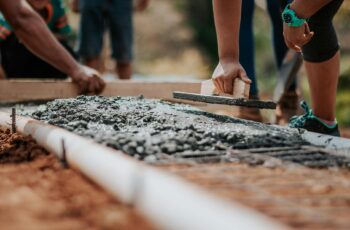A strong foundation is crucial for any structure, and when it comes to your home, a damaged concrete foundation can lead to significant problems. This blog post will guide you through the process of repairing your concrete foundation, empowering you to address issues effectively and prevent further damage.
Assessing the Damage
Before starting any repairs, it’s essential to thoroughly assess the extent of the damage. Look for cracks, settling, and any signs of water intrusion. Identifying the cause of the damage is just as important as identifying the damage itself.  Consider consulting a structural engineer for professional advice if you’re unsure about the severity of the issue.
Consider consulting a structural engineer for professional advice if you’re unsure about the severity of the issue.
Preparing for Repair
Once you’ve assessed the damage, gather the necessary tools and materials. This might include things like jackhammers (for more extensive repairs), concrete patching compound, and various mixing tools. Remember to prioritize safety by wearing appropriate protective gear, including gloves, safety glasses, and a dust mask. [IMAGE_2_HERE]
Cleaning the Damaged Area
Thorough cleaning is a crucial step. Remove any loose debris, dirt, or old mortar from the damaged area. Use a wire brush to clean the surfaces of the concrete, ensuring a strong bond for your patching material. For larger repairs, you might need to use a pressure washer, but be cautious not to damage the surrounding concrete. Learn more about pressure washing safety.
Applying the Patching Compound
Following the manufacturer’s instructions carefully is key when mixing and applying the patching compound. Ensure the mixture is consistent and workable. Apply the compound firmly into the damaged area, ensuring complete filling. Properly compacted compound will resist future cracking. [IMAGE_3_HERE] Find patching compound recommendations here.
Curing the Concrete
Allow the patching compound to cure according to the manufacturer’s recommendations. This usually involves keeping the area moist and protected from direct sunlight or freezing temperatures. Proper curing ensures the patch reaches its full strength and durability. Improper curing can lead to cracking and weakening of the repair.
Monitoring and Maintenance
After completing the repairs, it’s essential to monitor the area for any signs of recurring problems. Regular inspections can help you catch minor issues early on, preventing more extensive and costly repairs in the future. Learn more about preventative maintenance.
Advanced Repair Techniques
For more complex foundation issues, such as significant settling or extensive cracking, more advanced repair techniques might be necessary. These techniques can involve underpinning, which involves strengthening the foundation from below. Consult a foundation repair specialist for guidance on complex repairs. [IMAGE_4_HERE]
Using Epoxy Injections
In some cases, epoxy injections can be a suitable solution for repairing cracks in your concrete foundation. Epoxy injections are particularly effective for hairline cracks that extend through the foundation. This method is a less invasive alternative to larger scale repairs. Learn about the cost-effectiveness of epoxy injections.
Addressing foundation issues promptly is key to preserving your home’s structural integrity and value. While DIY repairs are sometimes possible, it’s crucial to understand your limitations. Always prioritize safety and consult professionals when necessary.
Frequently Asked Questions
What are the common signs of foundation problems? Cracks in the walls, sticking doors and windows, sloping floors, and water leaks are all common indicators of foundation issues.
How much does foundation repair typically cost? The cost of foundation repair varies greatly depending on the extent of the damage and the repair method used. It’s best to get multiple quotes from contractors.
Can I repair my foundation myself? Minor repairs might be feasible for DIY enthusiasts with experience, but major repairs are best left to professionals.
How often should I inspect my foundation? It’s recommended to inspect your foundation at least once a year, or more frequently in areas prone to extreme weather conditions.
What preventative measures can I take to protect my foundation? Maintaining proper drainage around your house, preventing water from accumulating near the foundation, and regularly inspecting for cracks are all essential preventative measures.

